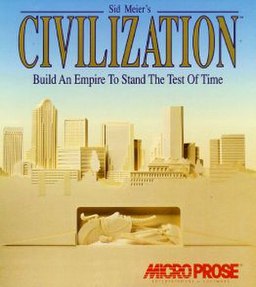
The Civilization series of video games gets its fifth installment on Tuesday. This is a highly anticipated release, so I am paying homage to it with a brief summary of the first four, to atone for all of the time I wasted on them.
Civilization (or Civ I) came out in 1991, and as such I don't remember actually playing too much of this one. The game introduced the basic model, which carries through to Civilization V. Build cities, research technology, build units and wage war. The unit combat is the simplest with each unit just having an attack value and defense value. The attack value of one unit is compared to the defense value of another, which produces a proportion. This is the chance the attacking unit will beat the defending. A random roll is done and one unit is destroyed, and the other survives, fully intact.
This results in the notorious "phalanx defeats tank" phenomenon in which ancient units can seem absurdly over-effective. The effect is worsened by stacking multiplicative modifiers, so that when a modern tank(attack 8) attacks a phalanx of spearmen (defense 2) that's a veteran (+50%) fortified (+50%) on a mountain (+200%), the two are evenly matched.

In 1996 Civilization II was released. There were a few big things that it changed. Firstly, the map shifted to an
isometric perspective, which became the standard for Civilization games. Secondly, units started with hit points (HP) and combat happened in rounds. Each round, the game randomly rolls, based on the proportion of attack to defense. This is repeatedly done until one of the units HP reaches zero. They made this change to eliminate the "phalanx defeats tank" problem of the first game, which it only partially addresses. I like this change because you have to "heal" up a victorious unit after a tough battle. Civ II added one last thing to the game-play of Civ I, a victory condition outside of just destroying all other civilizations and a scoring system. When one reached the later stages of the game, one would have the opportunity to construct a space-ship to Alpha Centauri. If one finishes building and launching the ship, it travels and reaches its destination, the game ends. The game also ends at 2020 regardless and scores are compared to determine the winner. The game scores each civilization base on the number of World Wonders they have built, happy population and years of peace (with bonus points if the game ended by reaching Alpha Centauri).

In 1999, Sid Meier released a non-"Civilization" game named Alpha Centauri (Sid Meier's Alpha Centauri or SMAC). SMAC was the spiritual successor to Civ II, as it was developed by the same team that produced Civ II. The game-play was nearly identical, however it introduced a unique feature: fully customizable units. SMAC also introduced unique Civilization bonuses, similar to those used later in Civilization 3, and government system bonuses similar to those in Civilization 4. Civ V also uses a special World Wonder as a win condition, like SMAC's Ascent to Transcendence.

Civilization III hit the market in 2001. In some ways Civ III was a step backward from SMAC. It did not have SMAC's elevation changes in the map, "group movement" for units (though it was added by a patch later) and robust government options. Despite this, Civ III introduced one of best new mechanics to the series: culture. This allowed your civilization to have a border and reveal the territory within it. Also, it carried over the concept of specialized units for improving terrain, from SMAC, in the form of workers. In Civ II, settlers filled that role. Civ III also expanded the victory conditions to Conquest, Domination, Cultural, Space Race and Diplomatic. From
Wikipedia:
A Conquest victory is achieved when no civilizations besides the player's exist, a civilization being eliminated when its last city is captured or destroyed.
A player wins a Domination victory by controlling two thirds of the world's land and population. 66% of the world's land area must be within the civilization's cultural borders, and 66% of the world's population must reside within the civilization's cities.
The Cultural victory is achieved when either one city the player controls has 20,000 or more culture points, or if the entire civilization meets a certain threshold (100,000 on a Standard map) and has at least double that of any other culture.
The Space Race is nearly identical to the Alpha Centauri victory condition from Civ II. The last win condition, Diplomatic, is achieved by building the U.N. World Wonder, getting elected "Secretary General" and winning the victory option election by a simple majority. The time limit game option also remains, the winner of which is determined by score in a similar fashion to Civ II.

The latest game in the series, Civilization IV, refines many parts of the Civilization formula. The victory conditions are nearly identical to Civ III, as well as the map being fairly similar. The game had a controversial addition to the game, religion, as well as "Great People". These special units came in the form of either
artists, merchants, prophets, engineers or scientists, and each had a slightly different one-time ability. Civ IV also refined the government options to easily the best system so far of flexible civics. The unit and combat system was also the best so far. From
Wikipedia:
Military units no longer have separate ratings for attack, defense and health, but instead a single strength rating. The combatants' strengths are modified by multiplicative promotion and circumstance bonuses, and the highest number generally wins. As of the game's most recent patch, a damaged unit loses half that amount of combat strength. The player may now check the probability of success before commissioning an attack. The revised combat system was largely in response to the "spearman-defeats-tank" problem that has plagued Civilization since its first iteration, wherein weak and obsolete units (generally controlled by the AI) would defeat stronger and more modernized forces (generally controlled by the player) on a far more regular basis than common sense would suggest possible.
One of my complaints with the combat system (which has persisted across the entire series), is the relative ineffectiveness of air units. They always seem to be tacked on as an afterthought and made to be glorified artillery. Also, the elevation system used in SMAC made a lot of sense. I feel it added to the immersiveness of the map layout, as well as allowing worker units (called terraformers in SMAC) to change the elevation of tiles to manipulate water (for example).
Lastly, I leave you with a quotation from Jerry Holkins at
Penny Arcade:
Via some methodology I am not entirely certain of, I received a working code for a review copy of Civilization V. I have played it enough to know that it is a game of clean lines and flawless ratios unbounded by the smooth corners of the world it simulates. It's perfect and deathless and it isn't going anywhere, ready the very moment I summon it to enclose me in its pure structures. It's the maximized centerfold archetype when what I'm after is filthy, anonymous, alleyway rutting. That's King's Bounty.














